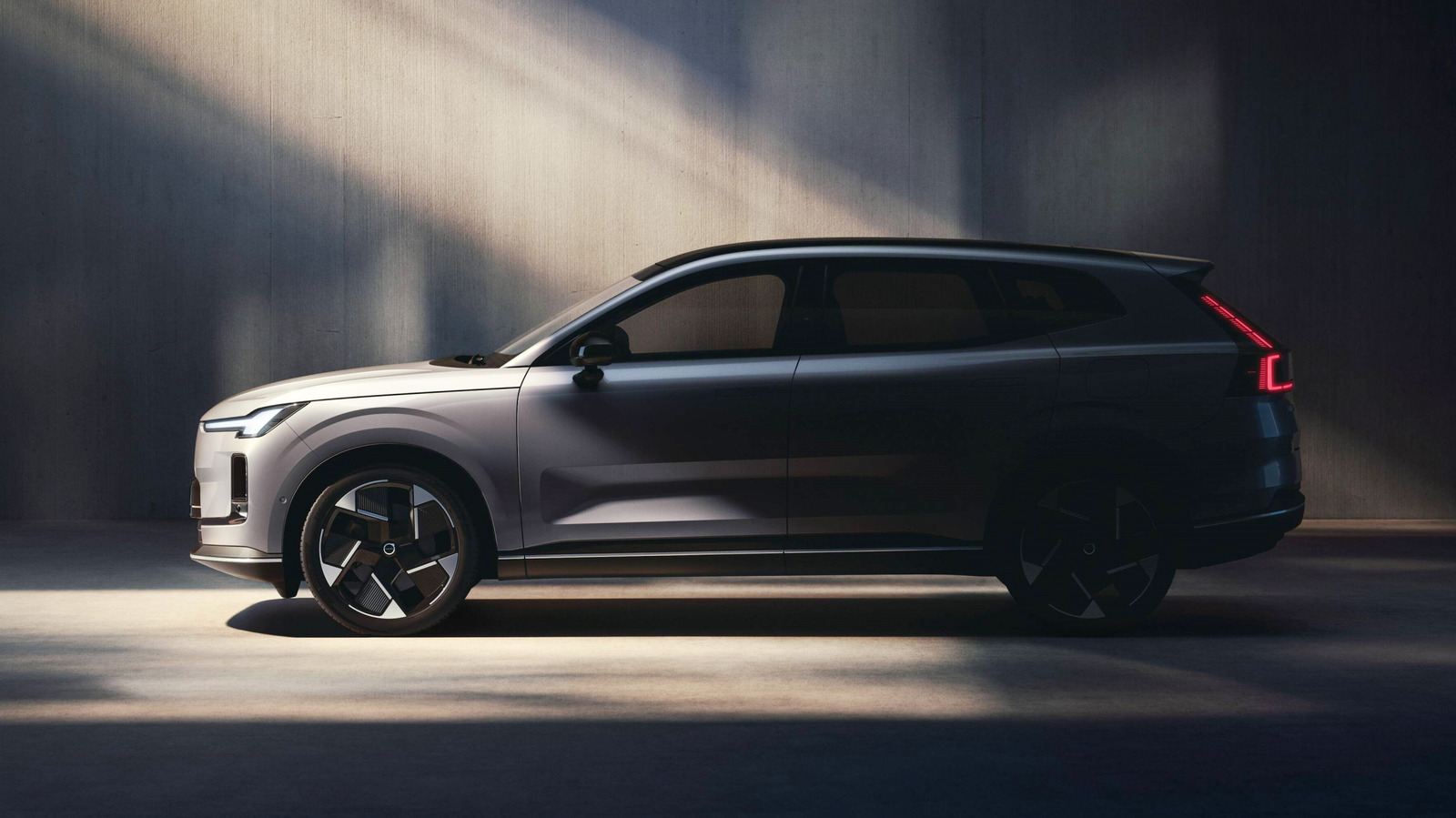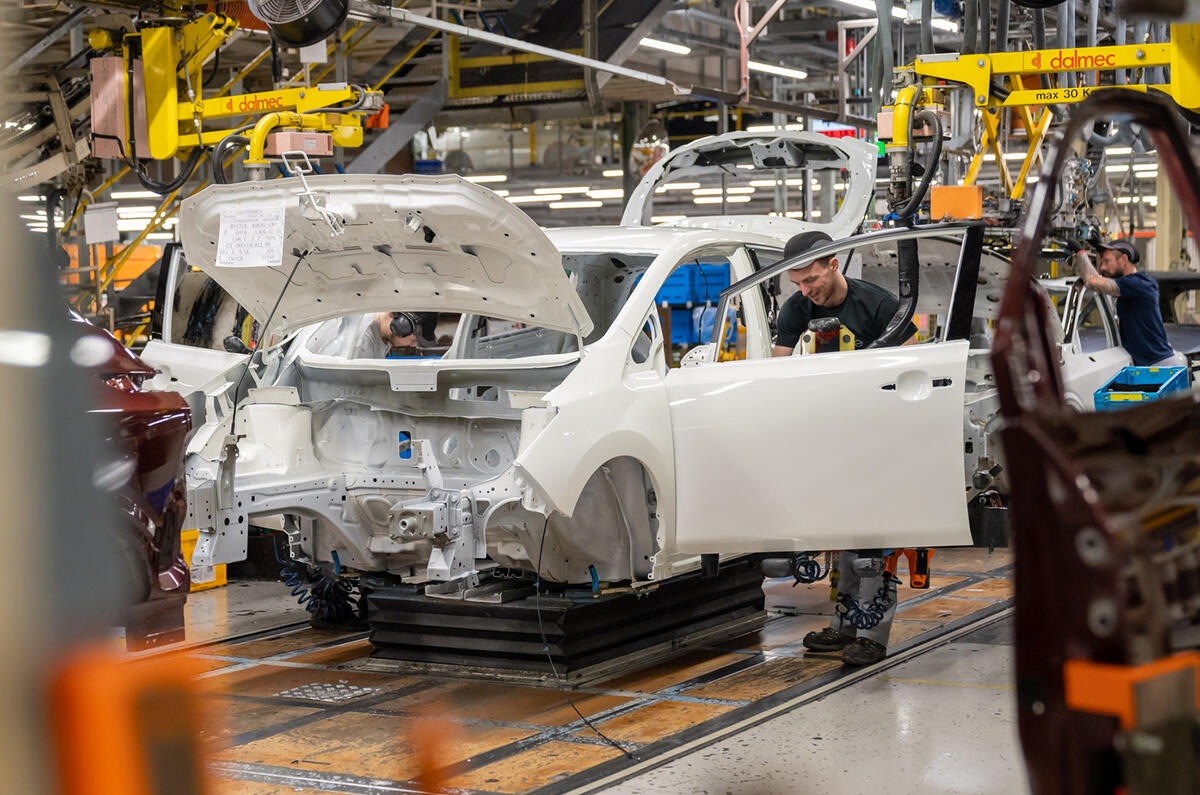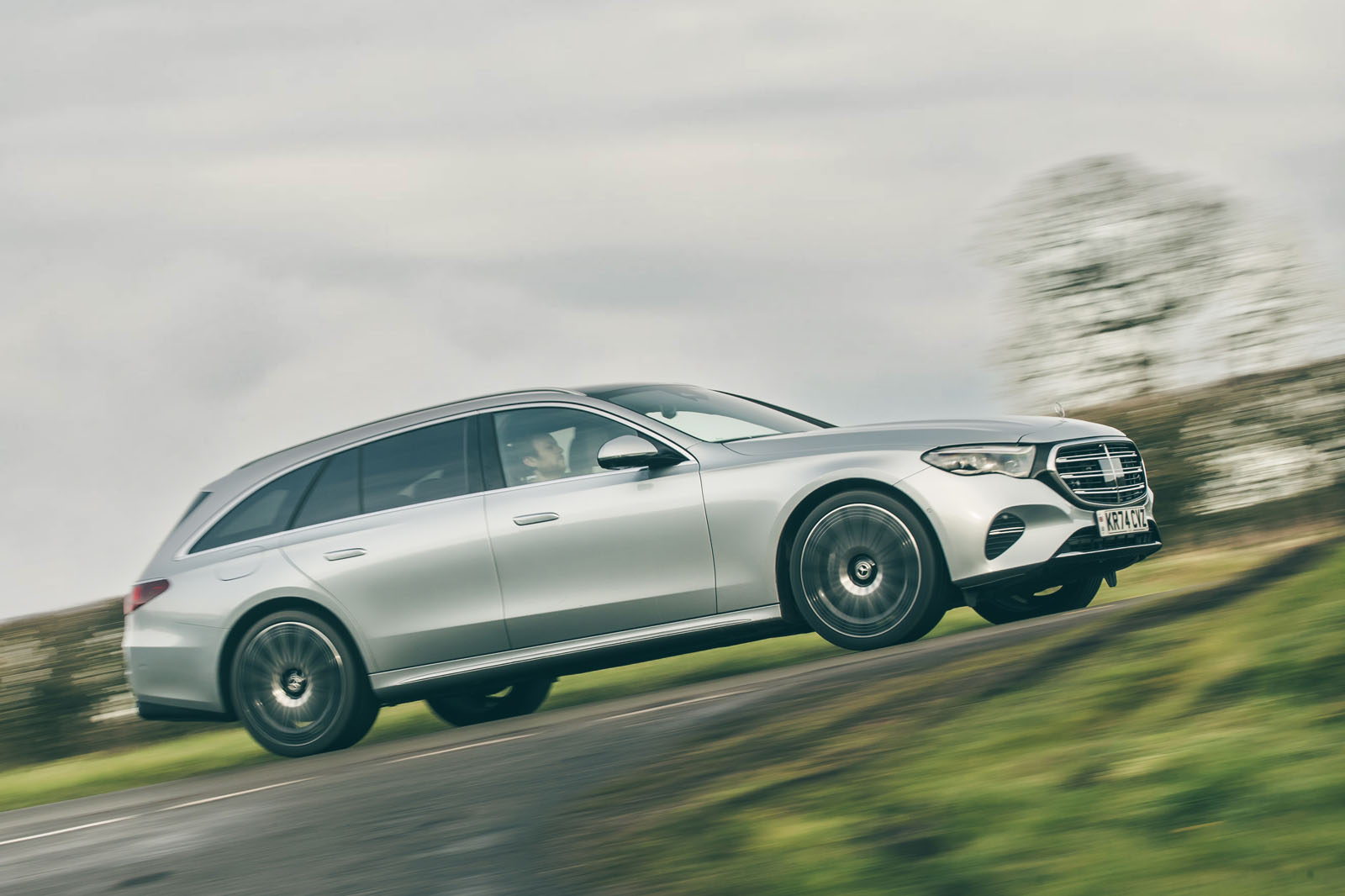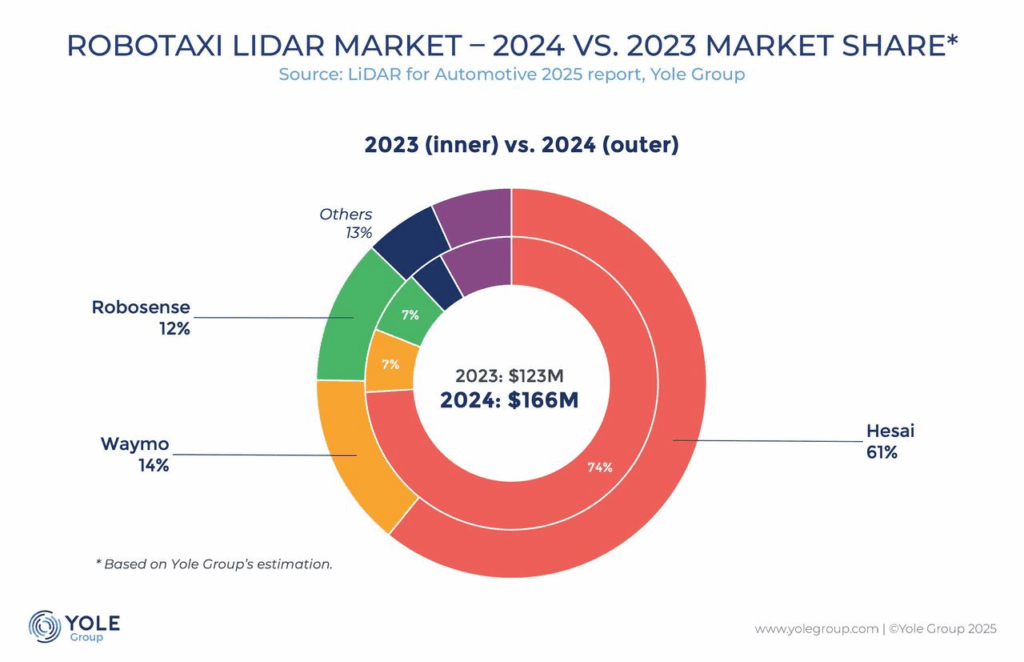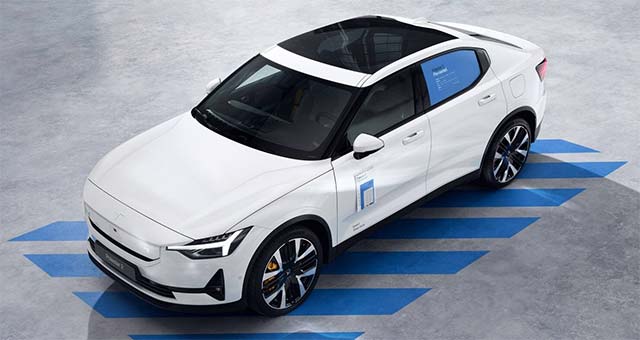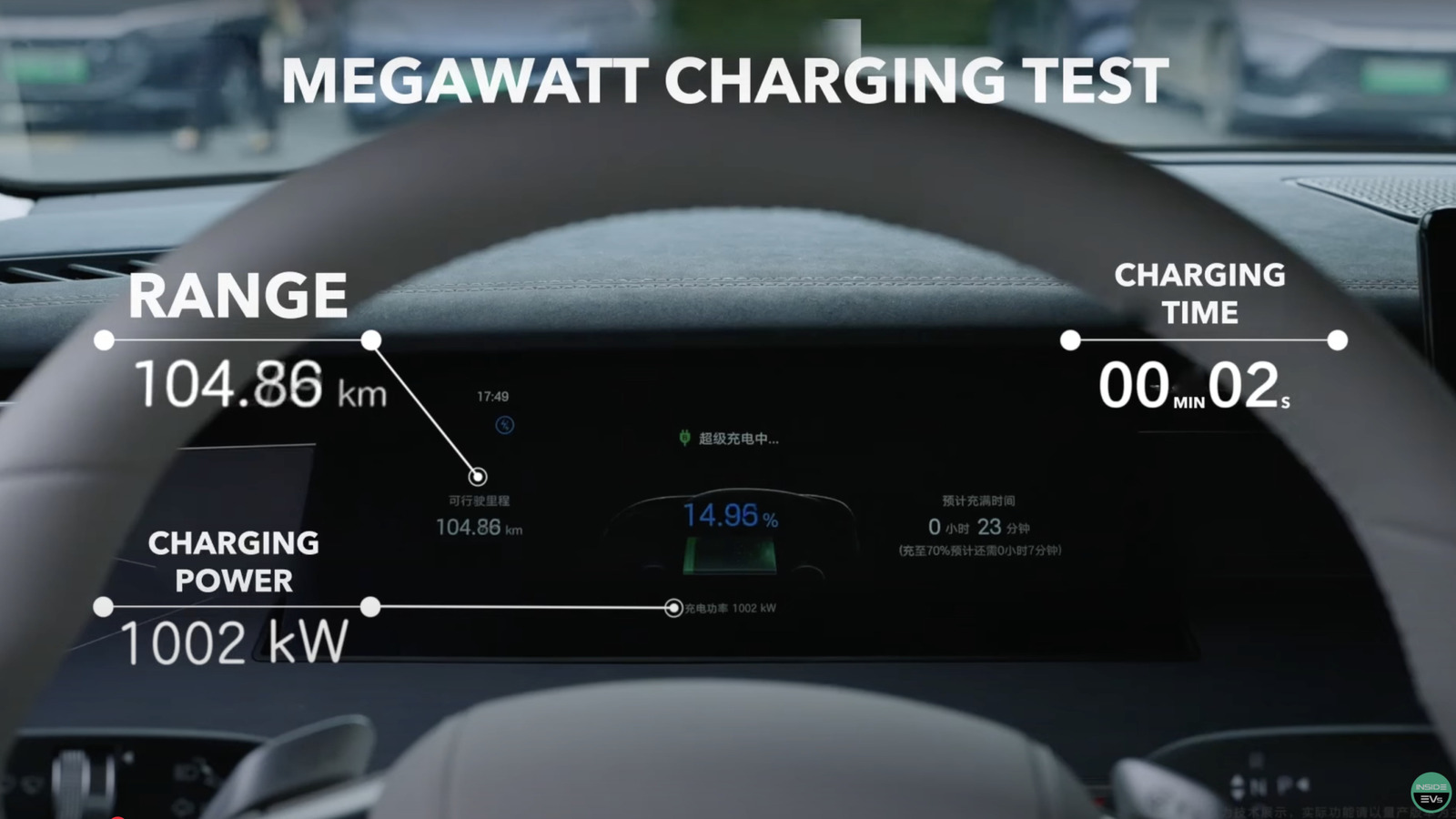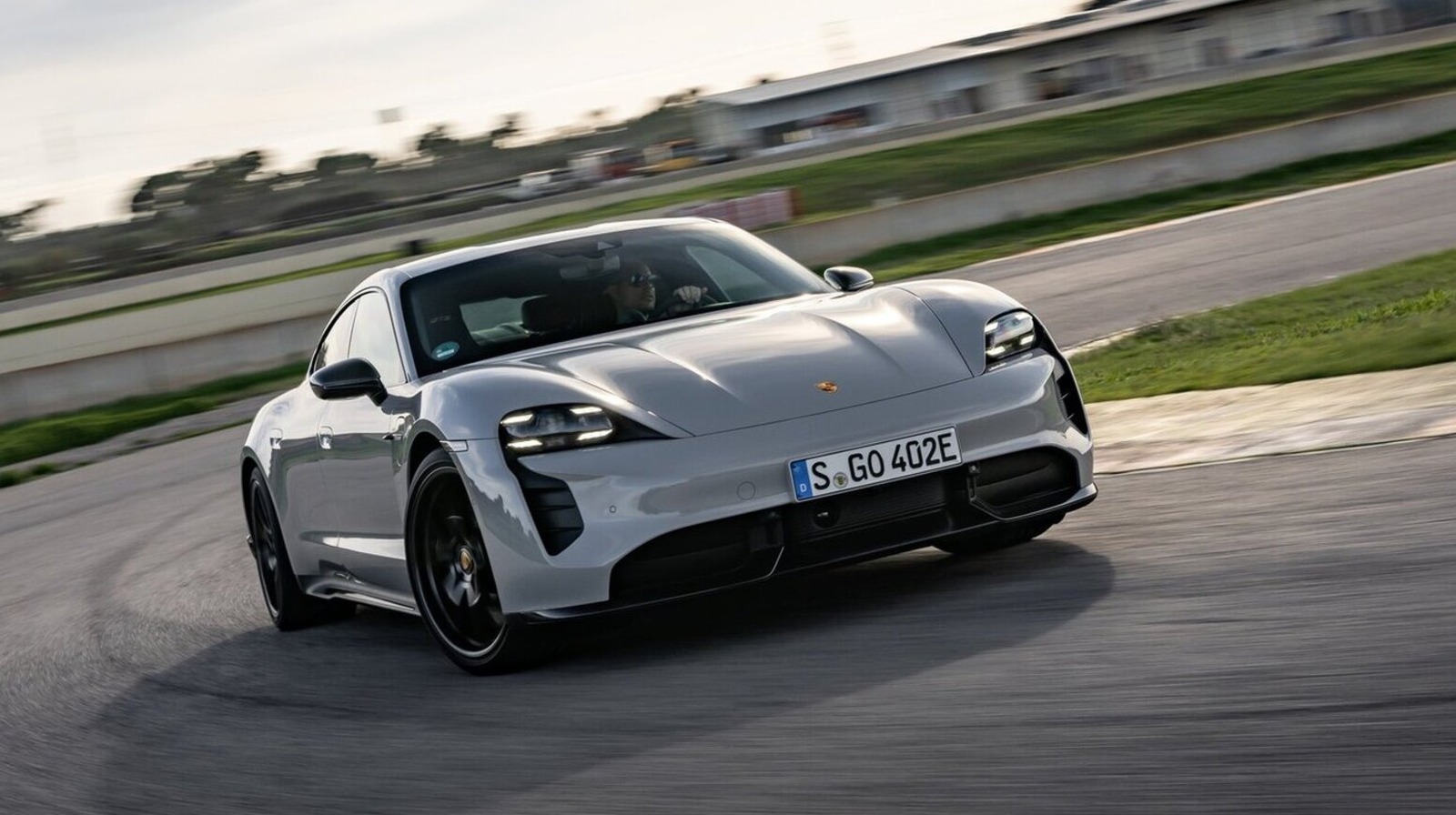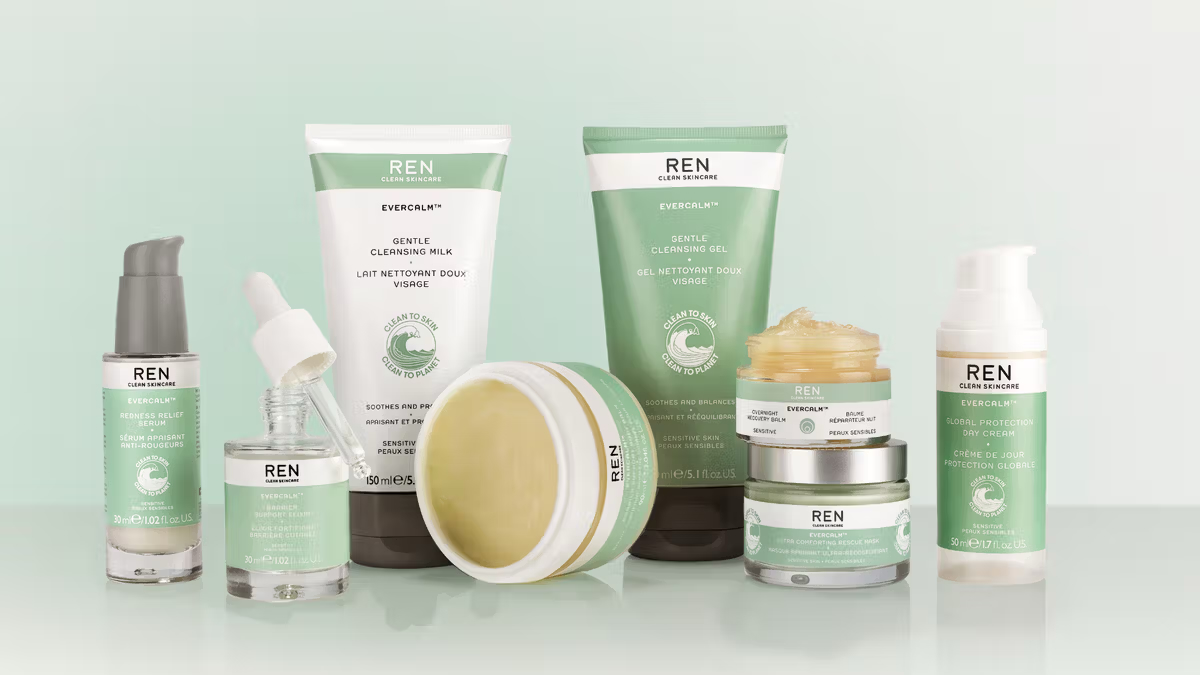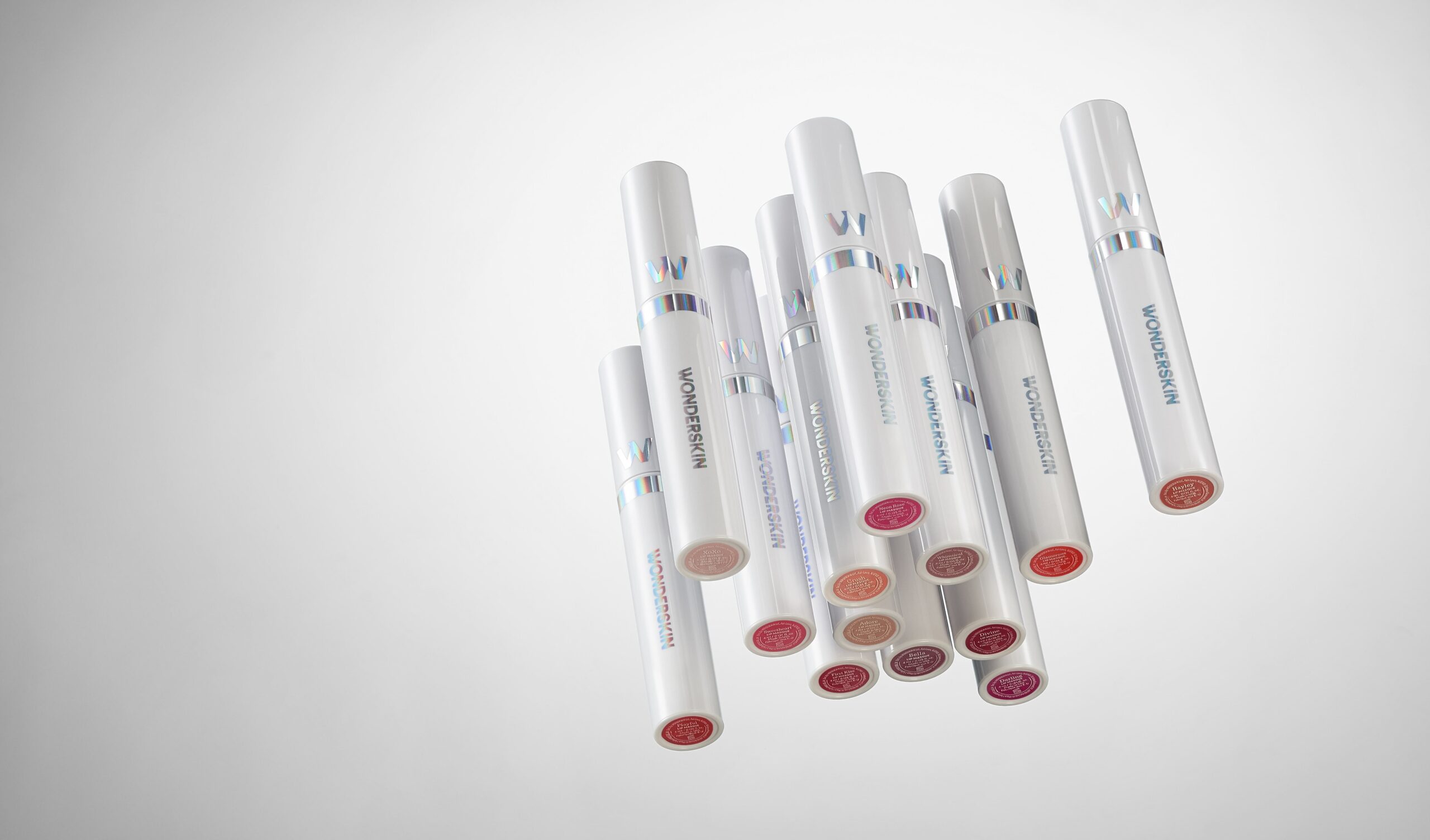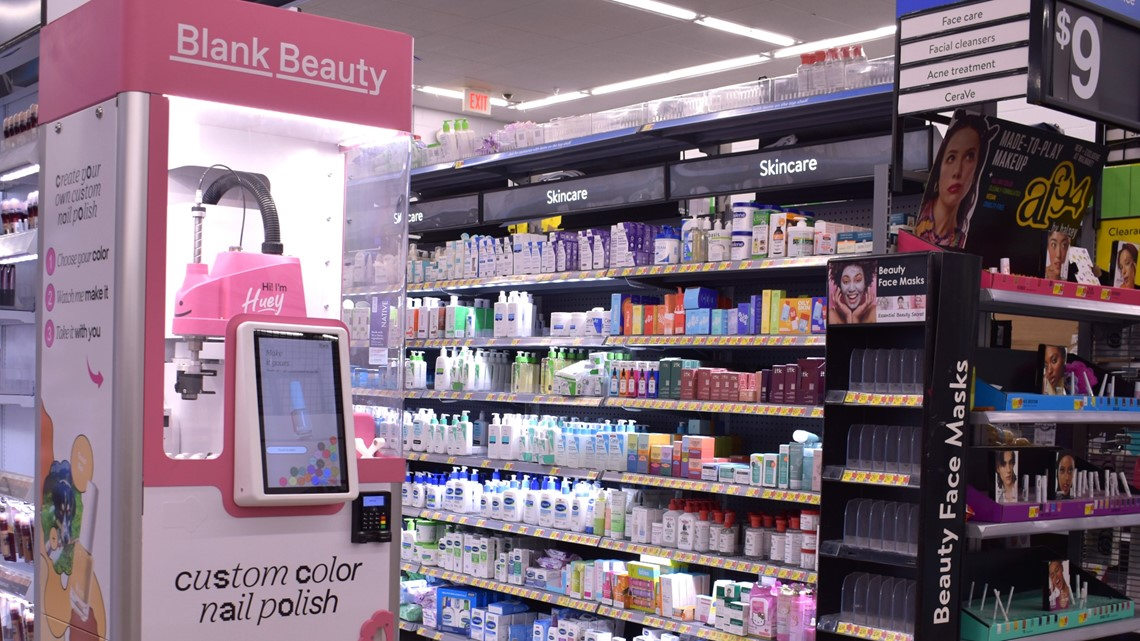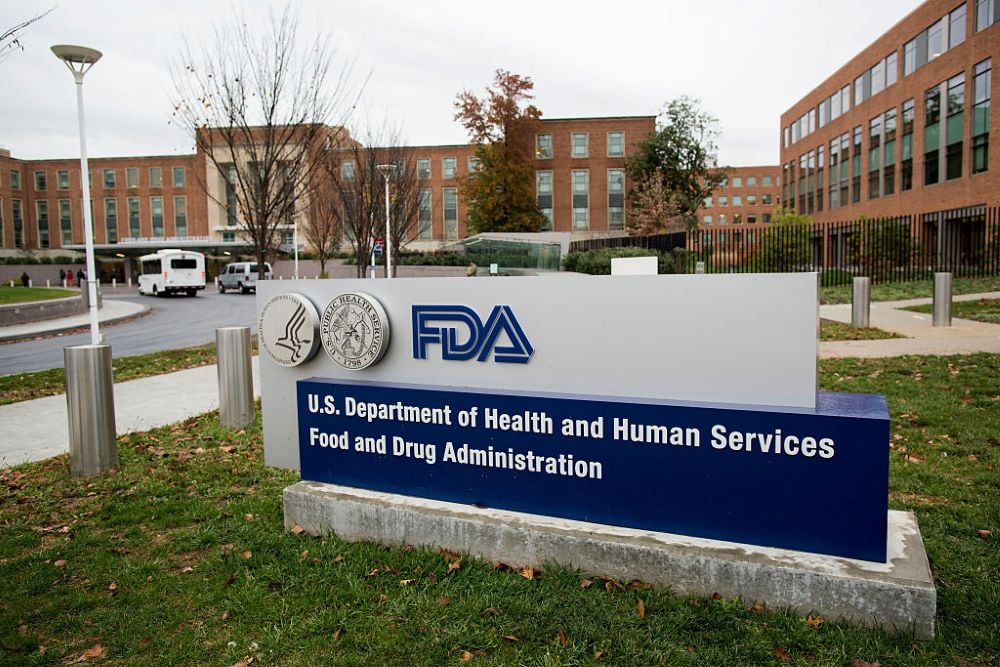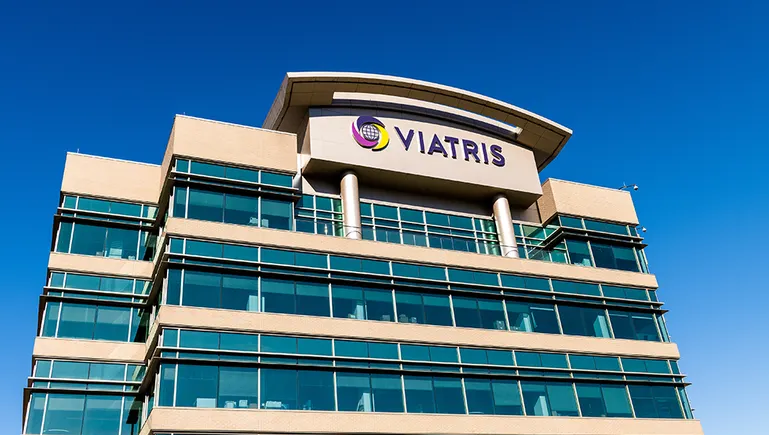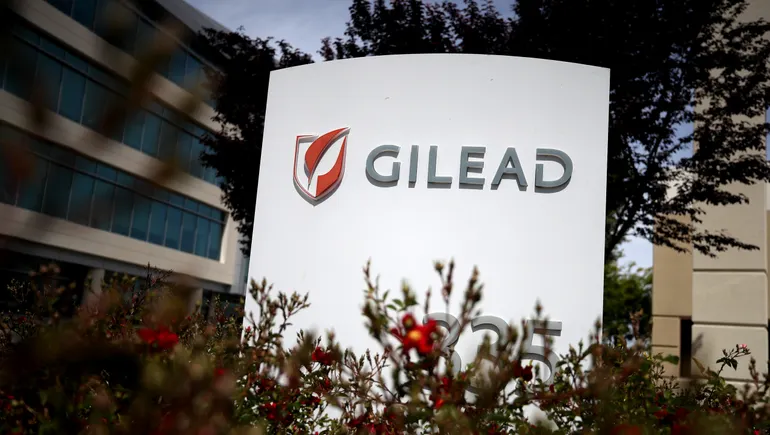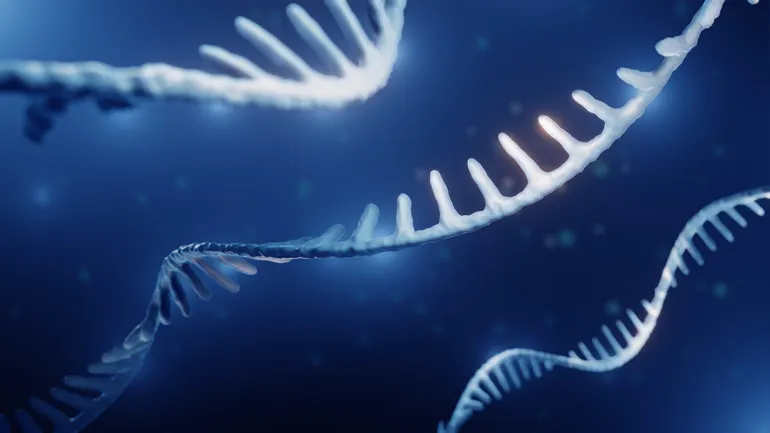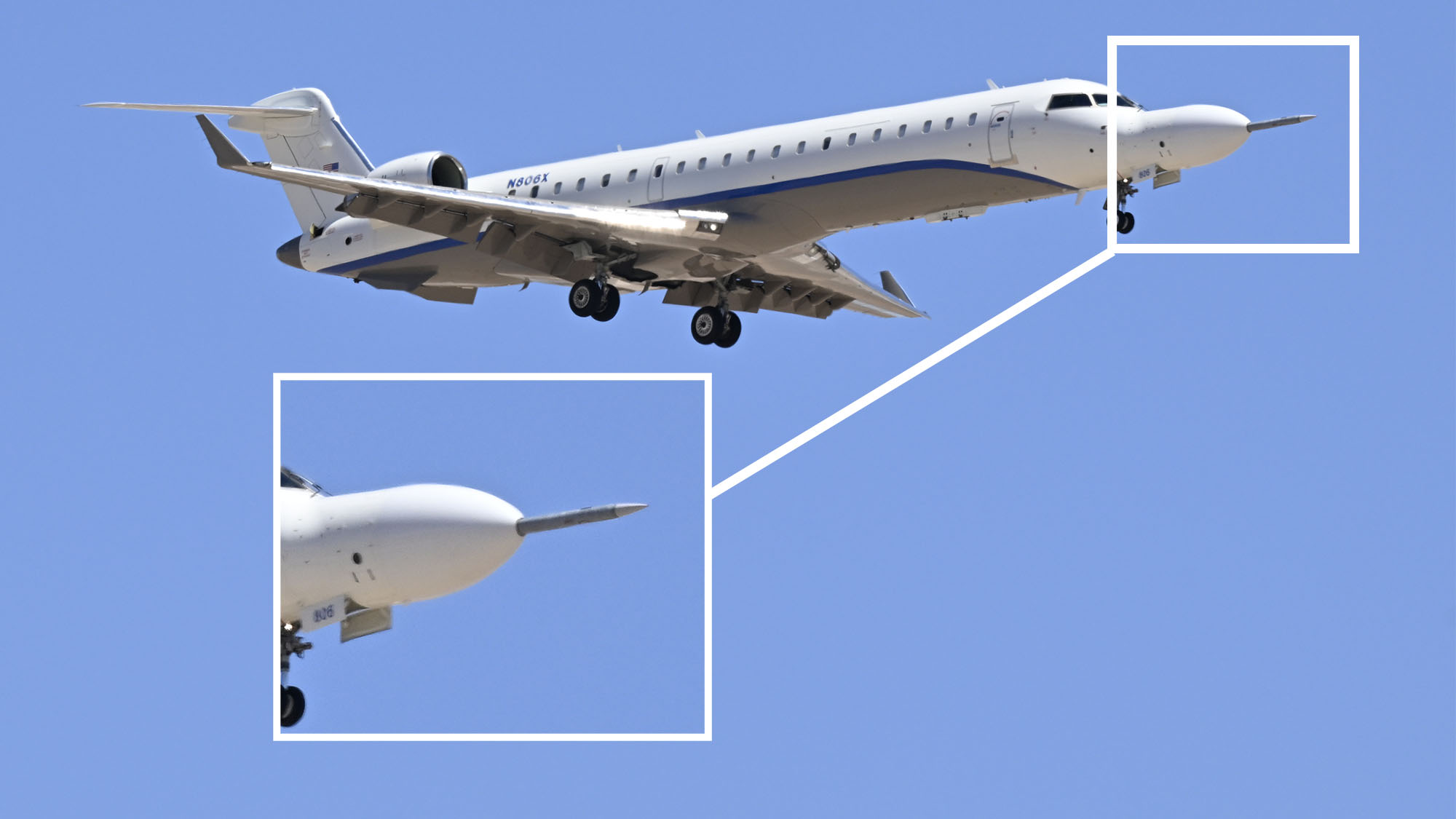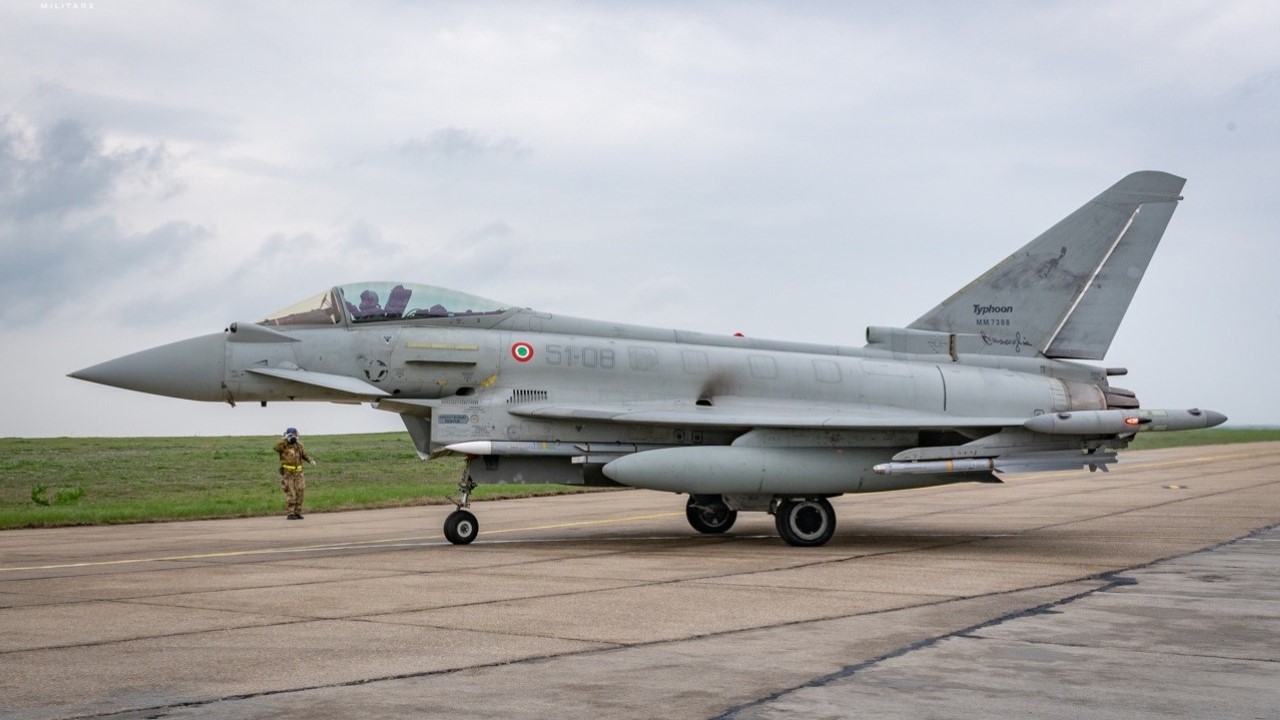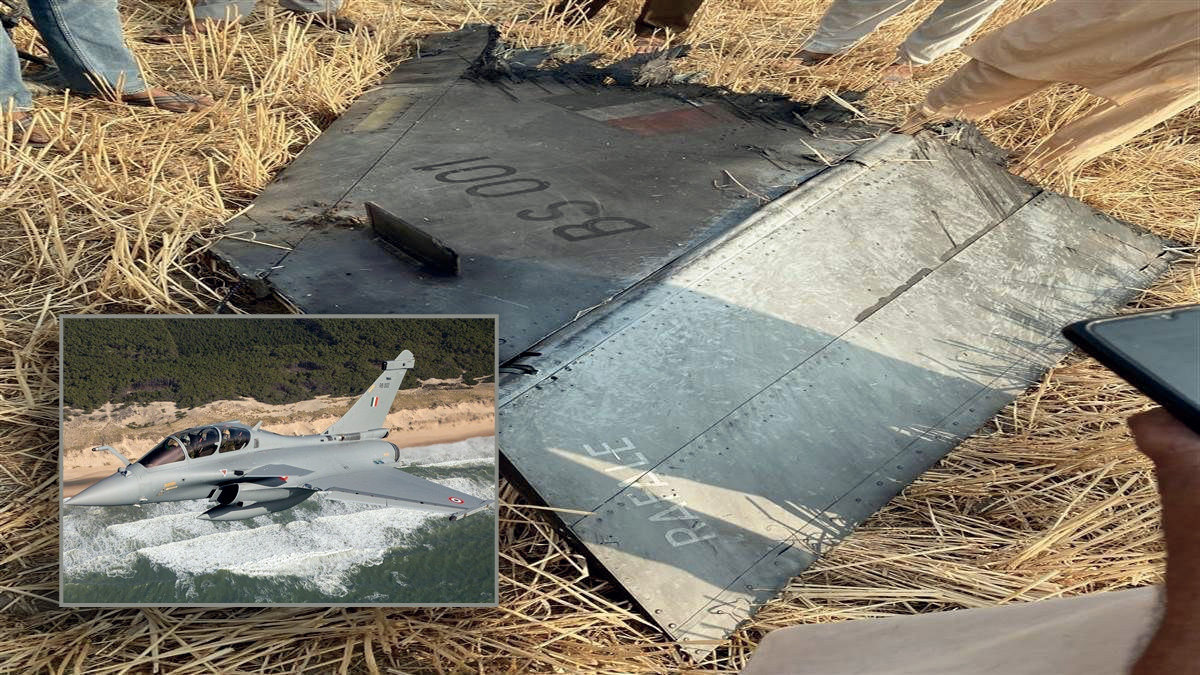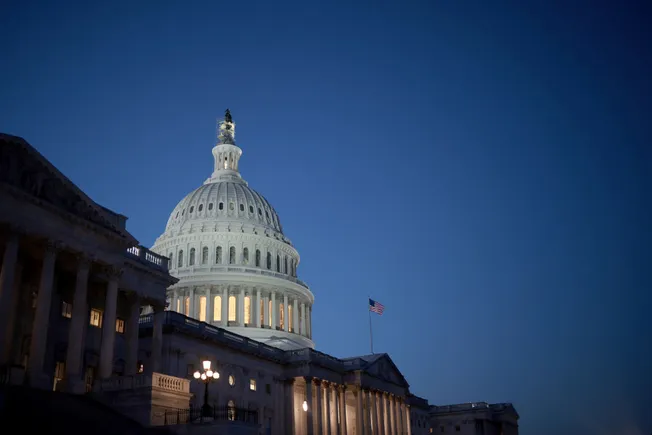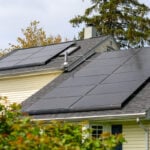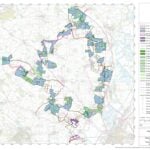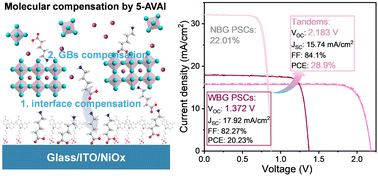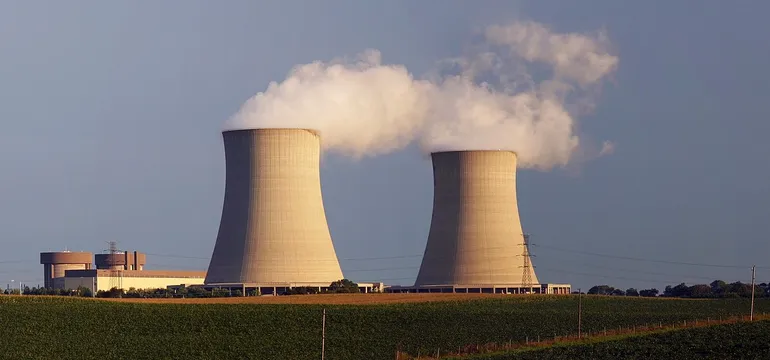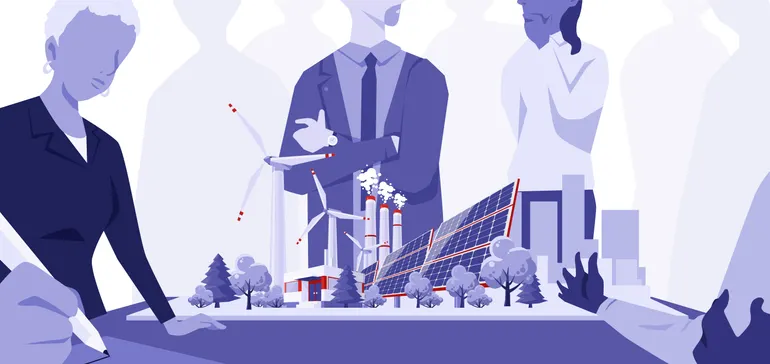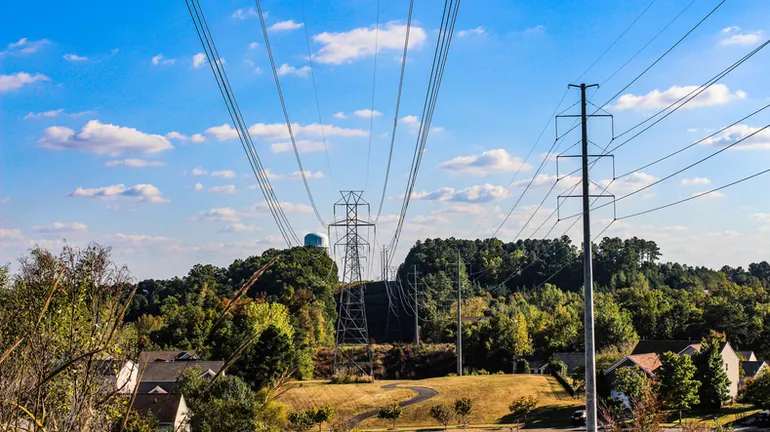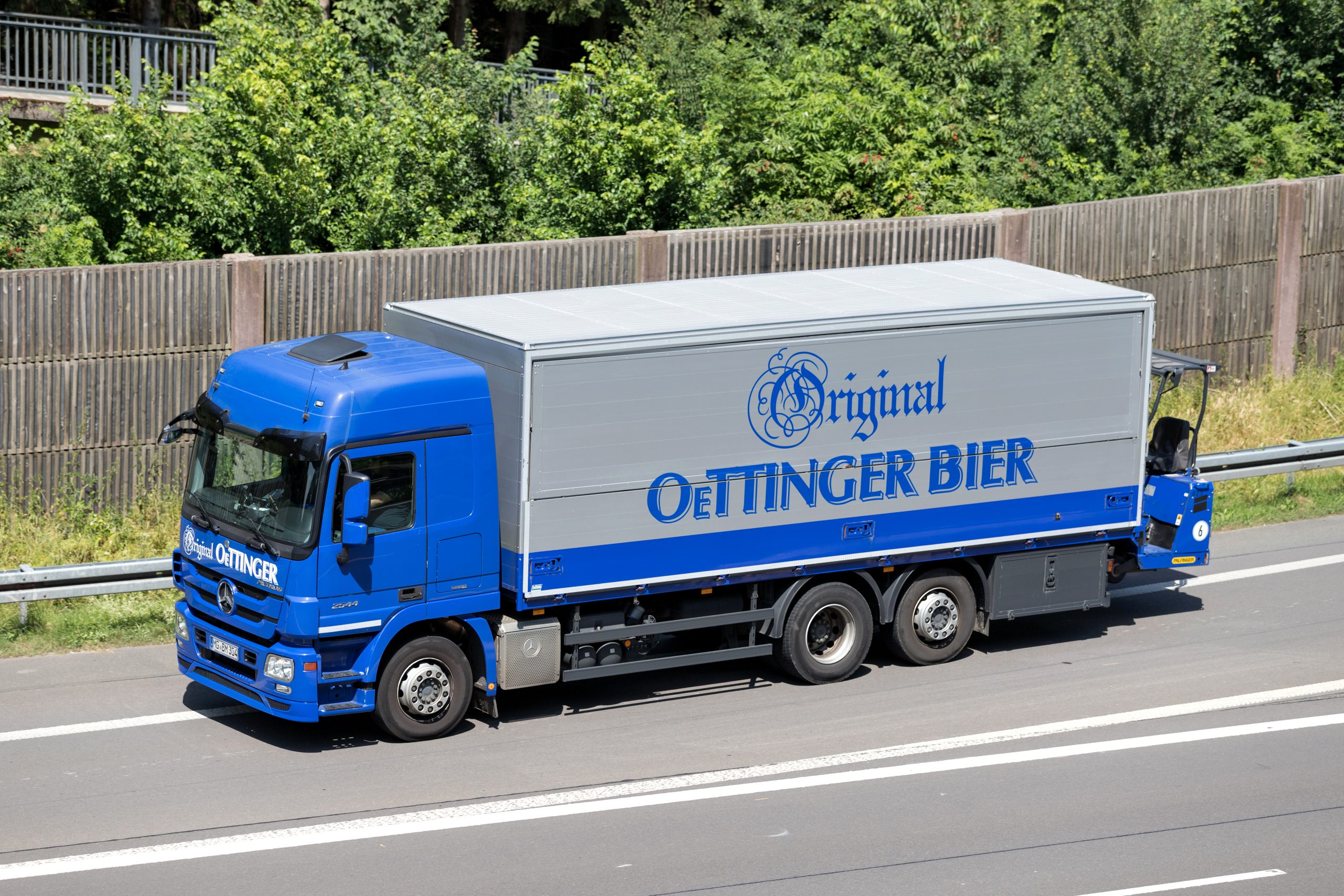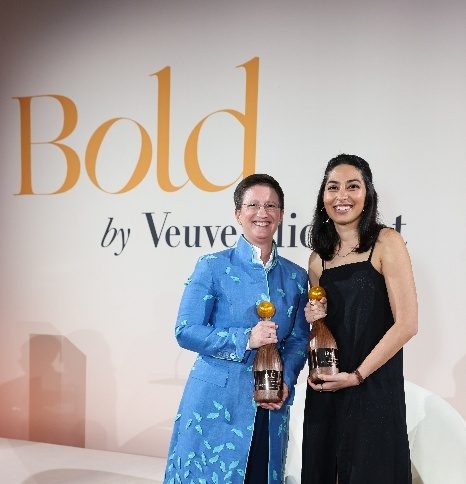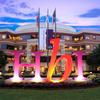I conclude my review of the right-bank in this complex and difficult vintage with a selection of the wines of the ‘satellite’ appellations of Saint-Émilion (Lussac, Montagne & St Georges), Castillon Côtes de Bordeaux, Côtes de Bourg, Canon-Fronsac, Fronsac and Lalande de Pomerol. There are also a handful of right-bank Bordeaux or Bordeaux Supérieur that I tasted along the way.

The 50 or so wines are listed alphabetically by appellation or appellation group.
Notable highlights:
- Les Perrières 93-95
- Grand Village 92-94
- Montlandrie 92-94
- Le Plus de la Fleur de Boüard 92-94
- Vieux Château Saint-André 92-94
- Le Rey Les Rocheuses 91-93+
- Clos Lunelles 91-93
- Les Cruzelles 91-93
- Fontenil 91-93
- Roc de Cambes 91-93
Value picks:
- Haut Carles 91-93
- La Chenade 90-92+
- Le Rey Les Argileuses 90-92
- Cap de Faugères 89-91+
A note on the ratings
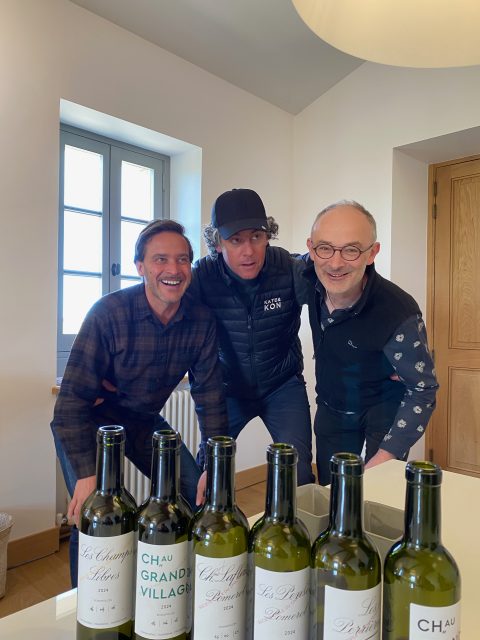
Alongside the published tasting notes is an indicative rating for each wine and although both comments and ratings are subjective, I would urge you to look at the two together and, if anything, to privilege the comment over the rating. My aim is more to describe the wine in the context of the vintage, the appellation and recent vintages of the same and similar wines, rather than to judge the wine per se.
The ratings reflect my subjective evaluations and relative preferences between wines and obviously your palate is likely to differ from mine. But I hope my comments give you at least enough information to be able to recalibrate my ratings and, in so doing, to align them more closely to your own palate
2024, like both of its predecessors is far from a homogeneous vintage and, consequently, my ratings span a considerable range. I see little interest, either for the consumer or the producer, in publishing very low scores, so I have decided not to publish scores for classed growths (or equivalent wines) rated below 90 (or 89-91 as a range) and for crus bourgeois (or their equivalents) rated below 88 (or 87-89). Where no rating is published, the wine would have scored below these thresholds.
Finally, élevage is likely to be very important in determining the quality in bottle of these wines. I am no soothsayer and cannot predict how that will turn out (another reason for the use of banded ratings). But all en primeur ratings should be treated with caution and taken with a certain pinch of salt.
Detailed tasting notes
Lalande-de-Pomerol
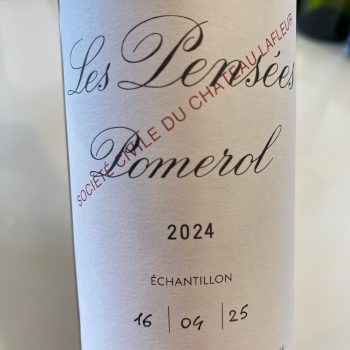 Château Canon Chaigneau
Château Canon Chaigneau (Lalande-de-Pomerol; 98% Merlot; 1% Cabernet Franc; 1% Malbec; 14% alcohol). Reassuringly familiar, I think I would pick this blind. There’s a little more intensity to this than the Cuve 8a, a very slightly broader frame and rather more layering and mid-palate density. That actually makes this brighter, crisper and more precise and energetic on the attack, but it also serves to draw more attention to the slightly elevated acidity on the finish. Interestingly, the ferrous minerality from the crasse de fer is also more evident.
89-91.
Château Canon Chaigneau Cuve 1a (Lalande-de-Pomerol; 100% Cabernet Franc; 14% alcohol). Light and aerial with a lovely very fresh, crisp blueberry fruit. We could almost be in Chinon! This is simple but engaging and quite creamy on the attack. But there’s no mistaking the somewhat slender frame and the lack of density in the mid-palate when compared to the grand vin (or, indeed, to previous vintages). But it’s authentic, engaging and a study in Cabernet Franc purity!
87-89.
Château Canon Chaigneau Cuve 8a (Lalande-de-Pomerol; 99% Merlot; 1% Malbec; 13.5% alcohol). Quite nutty aromatically, with walnut and blanched almond notes accompanying the dark plum and berry fruit, with a little sage and bay leaf. Pure and focussed and with quite a pleasant natural sweetness to the fruit at least on the attack. The acidity picks up towards the finish, but this has been well-managed.
88-90.
La Chenade (Lalande de Pomerol; 85% Merlot; 15% Cabernet Franc; aging in oak barrels, 52% new; 13.3% alcohol; tasted with Noëmie Durantou at L’Eglise Clinet). Dustier in its earthy minerality than the other wines in the line-up, with less of the ferrous note that it sometimes has. A bright, plump and sapid berry fruit. There’s a pleasing sense of harmony and balance. This is more like Saintayme in its levity and the form it takes in the mouth than the more serious and richer, darker-fruited, Les Cruzelles. There’s great prospective value to be found here! Noëmie has crafted an excellent wine in the context of the vintage.
90-92+.
Château Les Cruzelles (Lalande de Pomerol; 85% Merlot; 15% Cabernet Franc; aging in oak barrels, 57% new; 13.6% alcohol; tasted with Noëmie Durantou at L’Eglise Clinet). Ferrous in its minerality at first as ever. Gracious, quite ample, refined and with the same crystallinity that is present in all of these wines. But again, crucially, without the sensation of the fruit being stretched thinly over the structure. Dark berry fruits and plenty of blueberries from the Cabernet Franc. Some black cherries rounding this out after gentle aeration. Quite lush and plush with a juicy but rich finish that is very satisfying. Recommended.
91-93.
Enclos de Viaud (Lalande de Pomerol; 100% Merlot; a final yield of 22 hl/ha; pH 3.6; 13% alcohol; tasted at Bellefont Belcier with Emmanuelle Fulchi and Jean-Christophe Meyrou). Saline, with a distinctly ferrous touch to the minerality. Authentic plum and dark berry fruits, a little raspberry too. Very fine-grained tannins, showing the gentle extract – the Vignobles K signature. Fresh and quite delicate. Nicely managed. Light, of course, but that’s the right thing to do here.
87-89.
Domaine de Gachet (Lalande de Pomerol; 100% Merlot; 13% alcohol; tasted with François Estager at La Cabanne). More iron rich than the other wines in the portfolio and the fruit a bit redder in hue. Strawberries with red plums and plum skins. More juicy still on the palate. Easy and accessible but succulent, the wide frame accentuating the clarity of the mid-palate.
87-89.
Château Le Fleur de Boüard (Lalande de Pomerol). This is excellent. I love the purity and ripeness and precision of the fruit here – it reminds you how much you miss that in some of these wines. There’s a vivid clarity to this which is energising in a vintage in which so many wines are a little cloudy and indistinct in the mid-palate. Easy, accessible, bright and crunchy and likely to represent excellent value.
91-93.
Le Plus de la Fleur de Boüard (Lalande de Pomerol). Almost a little Valandraud-like in style, with the sleek use of oak – much more so than in La Fleur itself – reinforcing the floral character of the vintage and bringing out the violet-enrobed black cherries that are the star attraction here. Incense too and patchouli. Dark, rich, soft and velvety but at the same time lifted and quite ethereal, this transcends the limits of the vintage rather well. I imagine that the yield is tiny and the selection very strict.
92-94.
Castillon Côtes de Bordeaux
Château d’Aiguilhe (Castillon Côtes de Bordeaux; 90% Merlot; 10% Cabernet Franc; a final yield of 38hl/ha; 13% alcohol; tasted at Canon-La-Gaffelière with Stephan and Ludovic von Neipperg). Creamy. Black berry and fruits of the forest. Damsons and damson skin, with the little touch of tannin from the limestone terroir. A lovely dark fruit signature. Again, wild herbal notes – rosemary and thyme. Ample. Silky and crystalline. Quite gracious and yet authentic, with its chewy crumbly limestone tannins.
89-91.
L’Aurage (Castillon Côtes de Bordeaux; 13.5% alcohol). Toasty. A slightly confit fruit. Figs, fresh and dried. Dried flowers. Plums and baked plums. A little nutmeg and cinnamon. Sweet-scented on the attack and fluid and dynamic over the palate. Fresh and bright, this works very well in its style. Not massive in terms of extraction and more interesting for that. Lithe and tender on the finish.
89-91.
Château Cap de Faugères (Castillon Côtes de Bordeaux; 85% Merlot; 10% Cabernet Sauvignon; 5% Cabernet Franc; a final yield of 45.5 hl/ha; 13.5% alcohol; tasted at Faugères with Vincent Cruége). Nicely smoky with a deep, dark plummy fruit, plenty of expressive cassis notes too and a touch of wild herbs. Creamily textured, as is already evident from the aromatics – always an excellent sign. Bright, crisp and crunchy, with fresh red and dark berry fruits – cranberry, redcurrant, white current and black current. A narrow frame, a great purity and precision and a finish elongated by the work of the limestone tannins. Rippling and sapid to the end. Accessible and extremely juicy.
89-91+.
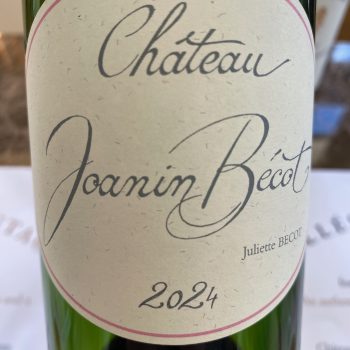 Château Joanin Bécot
Château Joanin Bécot (Castillon Côtes de Bordeaux; 80% Merlot: 20% Cabernet Franc; a final yield of 34 hl/ha; pH 3.5; 13.3% alcohol). Tasted at the property from a glass still warm from the washer, which didn’t help. Blackcurrant and a little bramble. A little hint of walnut and with a certain creaminess that comes from that. Vertical from the limestone terroir that is the star of the show here. More and more black currant with a little aeration – or, simply, time. Sapid, juicy, tight and tense, with a narrow frame, very sleek and slender but fully packed with croquant juicy sapid fruits. Tender and chewy in a very tactile way on the finish, but with never any hint of dryness or astringency. Neither the complexity nor the richness of recent vintages, but accessible and engaging.
89-91.
Clos Lunelles (Castillon Côtes de Bordeaux; 70% Merlot; 20% Cabernet Franc; 10% Cabernet Sauvignon; a final yield of 25.1 hl/ha; pH 3.44; 13.9% alcohol; tasted at Château Pavie). A lovely lifted dark berry fruit – very fresh but pure and precise and intense. Bravo. I love the vertical lift that seems to come from the limestone terroir here and the gently hint of florality. Intense and quite rich and compact for the vintage but above all aerial. Lovely black cherries on the palate with a little blueberry. Pure, focussed, but dense and compact too. Creamy at first, before the engagement of the crumbly limestone tannins that twist and squeeze this on the finish. Excellent.
91-93.
Château Montlandrie (Castillon Côtes de Bordeaux; 60% Merlot; 20% Cabernet Franc; 20% Cabernet Sauvignon; aging in oak barrels, 42% new; 13% alcohol; tasted with Noëmie Durantou at L’Eglise Clinet). Gorgeous aromatically. Black cherry. Blueberry. Bramble. Quite subtle, with a little hint of florality – peony and wisteria – and a rather gracious quite intense dark berry fruit signature. A touch of damson skin too and the slight hint of tannin with it. Dense and compact, vividly juicy from the attack, the fruit in the mouth a little redder and more vibrant in hue. That gives this a lovely racy sense of energy and vivacity. There’s great finesse on the finish from the touch and sculpting of the wine by the calcaire tannins.
92-94.
Château Le Rey Les Argileuses (Castillon Côtes de Bordeaux; the green and blue clay parcel plots from Le Rey; 80% Merlot; 20% Cabernet Franc; a final yield of 32 hl/ha; pH 3.4; 13% alcohol; just put in bottle; tasted at Bellefont-Belcier with Emmanuelle Fulchi and Jean-Christophe Meyrou). Very mineral, very pure, impressively layered and very precise. Wonderfully crystalline. Simple but incredibly pure and so expressive of its terroir.
90-92.
Château Le Rey Les Rocheuses (Castillon Côtes de Bordeaux; the limestone parcel plots from Le Rey; 80% Merlot; 20% Cabernet Franc; a final yiel of 31 hl/ha; pH 3.3; 13% alcohol; tasted at Bellefont-Belcier with Emmanuelle Fulchi and Jean-Christophe Meyrou). The Cabernet Franc really signs so eloquently here. Gorgeously pure and, again, hyper-crystalline in texture. Sapid and lithe and sinuous and brilliantly expressive of this terroir and, indeed, this terroir type. Buy this, put it alongside the Argileuses cuvée and start the conversation! Great.
91-93+.
Côtes de Bourg
Domaine de Cambes (Côtes de Bourg; 80% Merlot; 20% Cabernet Franc). Very toasty. A little richer, a little more sapid and fresh on the palate, but still with the very evident signature of the Radoux blend casks. A narrow frame packed with fresh fruits. Linear, long and with a slowly tapering finish. The sucrosity from the oak is well-tempered by the freshness of the berry and, above all, stone fruits.
90-92.
Roc de Cambes (Côtes de Bourg; 80% Merlot; 20% Cabernet Sauvignon). A little less toasted, more plump and the fruit is fresher and less dominated by the oak and toast-of-the-oak signature of Domaine de Cambes and L’Aurage. Dark berry fruits are much more evident here. It’s nuttier too. A little fig and black pepper. Broader in frame and more spherical in form. Toasty notes emerge towards the lifted finish. Very ‘Mitjavile’!
91-93.
Bordeaux & Bordeaux Supérieur
Château Grand Village (Bordeaux Supérieur; 88% Merlot; 12% Bouchet; around 40-42 hl/ha; c. 13.2% alcohol; tasted with Ormi Ram and Baptiste Guinaudeau at Lafleur). Bright, crisp and with very crunchy red berry fruits, all beautifully al dente. There’s a very distinct earthy, clay-y, minerality too. Very pure and quite lifted, aromatically and structurally. The acidity is electrifying here, rendering this energetic, taut and tense. Very long and linear on the finish, with a delicate florality at the back of the palate.
92-94.
Les Perrières de Lafleur (Bordeaux Supérieur; 20% Merlot; 80% Bouchet; a final yield of around 40-42 hl/ha; tasted with Ormi Ram and Baptiste Guinaudeau at Lafleur). A little darker in its fruit profile, more dense and intense. The Bouchet really sings. This is very bulby in its florality. Peony and iris. Loganberry and blueberry. It is very true to its calcaire terroir too – a study in limestone, above all in this vintage! Sumptuous and that brilliant integration of the freshness and the limestone tannins. As pure a terroir influence in a wine as it is possible to imagine. A wine that almost re-defines what purity means. Very linear, very chiselled and very structural.
93-95.
Château Reignac (Bordeaux; 65% Merlot; 5% Cabernet Franc; 30% Cabernet Sauvignon; a final yield of 30 hl/ha; Michel Rolland is the consultant). Intriguing, with red and darker cherries, cherry stone and crushed dark berry fruits, a little espresso coffee bean too. This is glossy, limpid and quite lithe on the palate, yet at the same time very linear. A nice sense of balance and just on the right side of becoming austere. A tad dry on the finish, but less so than many.
87-89.
Lussac St-Emilion
Château Courlat Cuvée Jean-Baptiste (Lussac St-Emilion; 100% Merlot; a final yield of 33 hl/ha after densimetric sorting; pH 3.5; 30% new oak; tasted at Clos du Clocher). Lush and full, and nicely mouth-filling. There’s a little ferrous note to the minerality. Dark plummy fruits. Brambles. A little florality. The Rpulse extraction really helps here, above all texturally. A touch of chocolate. Full and crystalline, with lovely grippy tannins. Very impressive. Crumbly and chalky on the finish.
89-91.
Montagne St-Emilion
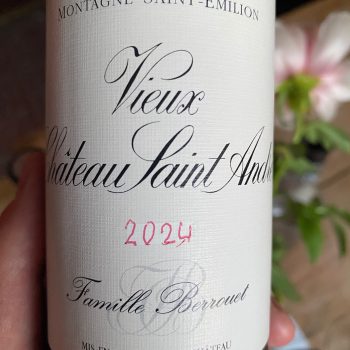 Vieux Château Saint André
Vieux Château Saint André (Montagne Saint-Emilion; 85% Merlot; 15% Cabernet Franc; from 4 hectates on clay and limestone; a final yield of 35 hl/ha; 13.5% alcohol). This is a wine that was sent to me in Paris that I would not otherwise have tasted. Shame on me. It’s brilliant and it shows what is possible in a vintage like this. OK, it’s made by the Berrouet family (more famous for their exploits in Pomerol – think ‘blue clay’!). But not even that prepares you for how good this is. Reductive at first, this takes it times to open in the glass and requires a bit of patience. When it does it has the most picture-perfect aromatic signature of fresh ripe raspberry and loganberry – one can almost sense the hairs on the delicate surface of the fruit. And they bring the hairs on the back of my neck to attention. Indeed, texturally we have something very similar with, at first, the sculpting of a broad and ample, soft and luxuriant frame with, then, the delicate, fine and powdery yet pointy tannins gripping at the edges and almost folding freshness into the mid-palate like a baker kneading bread. Fresh, pure, soft and enticing, yet tactile and dynamic, this is a very eloquent and rather beautiful expression of the vintage.
92-94.
Canon-Fronsac & Fronsac
Château Canon Pécresse (Canon-Fronsac; 70% Merlot; 30% Cabernet Franc; pH 3.5; 13% alcohol; Julien Viaud is the consultant here; certified organic and practicing biodynamic viticulture). A little more volume, plushness and richness than many with a pleasingly ample palate of dark berry and stone fruits. The acidity is definitely a little elevated in comparison with recent vintages, but it’s well managed and well incorporated. One of the best wines of this sector undoubtedly in 2024.
87-89.
Château de Carles (Fronsac). A wine I often love, and 2024 is no exception. This is very sleek and stylish, clear, precise and well-focussed with a brightness and a clarity that is rare in any vintage, particularly this one. The tannins are very fine-grained and have a lovely beady limestone character. They bring detail and delineation. Tender and fresh, this is an excellent wine with some aging potential that will be accessible from the moment it’s in bottle.
90-92.
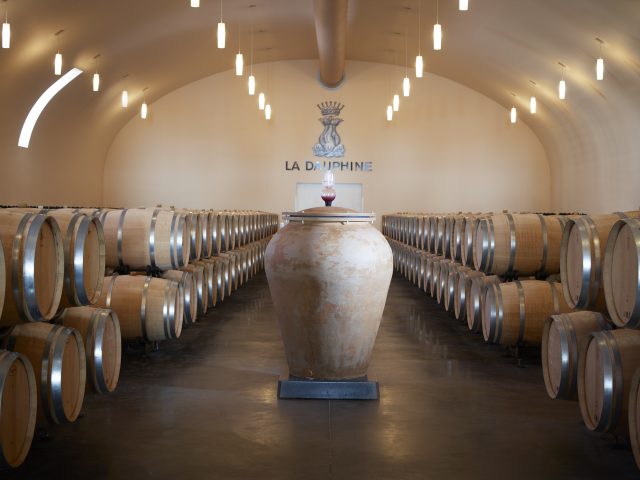 Château La Dauphine
Château La Dauphine (Fronsac; 75% Merlot; 25% Cabernet Franc; pH 3.5; 13% alcohol; certified organic and biodynamic; Julien Viaud is the consultant here). Creamy, fresh, pure and engaging aromatically, as it always is, the gentleness of the extraction coming in part from the use of the Rpulse system (as for instance at Brane Cantenac). This is perhaps a little introvert at first. Fruits of the forest and wild herbal notes, almost a touch of heather and whiff of iodine. I love the small dark berries that seem to explode in the mid-palate. Cool without ever being austere, this is vivid, racy and lively.
90-92+.
Château Fontenil (Fronsac; 100% Merlot; a final yield of 19 hl/ha; 14% alcohol; Michel Rolland’s family property). I rather like this. It’s very pure and very linear and quite aerial in its Fronsac signature – very true to and expressive of its terroir and appellation. An intense blueberry and bramble fruit, a little walnut shell and with a hint of the tannins of the walnut’s skin, this is crisp on the attack and crumbly and textured on the finish. If you still need to be disabused of the idea that Michel Rolland is all about wood, taste this!
91-93.
Haut-Carles (Château de Carles) (Fronsac). Just a little fuller, a little more plush and a little more sumptuous than de Carles which is already excellent. This, I presume, sees a little more oak too. It’s more serious and more age-worthy, but very much cut from the same cloth – and out of the same limestone quarry! The tannins are the key ingredient here. This is authentic Fronsac and very architectural in form as a consequence.
91-93.
Château Les Trois Croix (Fronsac). Lifted and bright and crunchy with bunches of freshly picked red berries – strawberries and raspberries. There’s a nice sense of harmony and precision. Simple, accessible and very fruit forward, this will make of early drinking and bring plenty of pleasure. I like the grainy calcaire tannins on the finish, giving this additional length.
87-89.
For full appellation-by-appellation reviews, see here:
St-Estèphe, Pauillac,
Saint-Julien,
Margaux, Haut-Médoc, Listrac-Médoc, Médoc, & Moulis-en-Médoc,
Pomerol,
Saint-Émilion, ‘satellite’ appellations of Saint-Émilion (Lussac, Montagne & St Georges),
Pessac-Léognan & Graves rouge,
Pessac-Léognan & Graves white, and
Sauternes & Barsac.
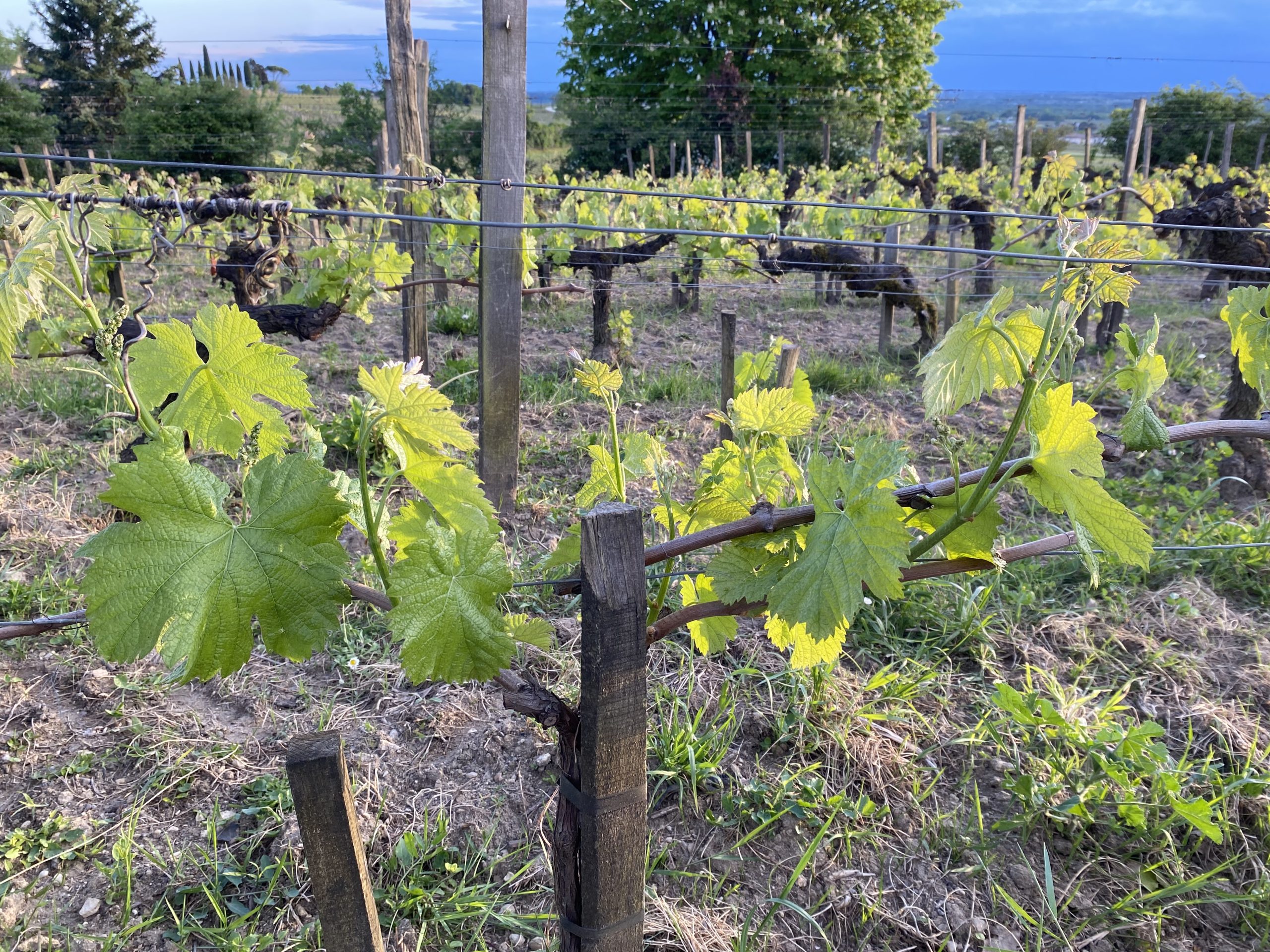
 The 50 or so wines are listed alphabetically by appellation or appellation group.
The 50 or so wines are listed alphabetically by appellation or appellation group.
 Alongside the published tasting notes is an indicative rating for each wine and although both comments and ratings are subjective, I would urge you to look at the two together and, if anything, to privilege the comment over the rating. My aim is more to describe the wine in the context of the vintage, the appellation and recent vintages of the same and similar wines, rather than to judge the wine per se.
The ratings reflect my subjective evaluations and relative preferences between wines and obviously your palate is likely to differ from mine. But I hope my comments give you at least enough information to be able to recalibrate my ratings and, in so doing, to align them more closely to your own palate
2024, like both of its predecessors is far from a homogeneous vintage and, consequently, my ratings span a considerable range. I see little interest, either for the consumer or the producer, in publishing very low scores, so I have decided not to publish scores for classed growths (or equivalent wines) rated below 90 (or 89-91 as a range) and for crus bourgeois (or their equivalents) rated below 88 (or 87-89). Where no rating is published, the wine would have scored below these thresholds.
Finally, élevage is likely to be very important in determining the quality in bottle of these wines. I am no soothsayer and cannot predict how that will turn out (another reason for the use of banded ratings). But all en primeur ratings should be treated with caution and taken with a certain pinch of salt.
Alongside the published tasting notes is an indicative rating for each wine and although both comments and ratings are subjective, I would urge you to look at the two together and, if anything, to privilege the comment over the rating. My aim is more to describe the wine in the context of the vintage, the appellation and recent vintages of the same and similar wines, rather than to judge the wine per se.
The ratings reflect my subjective evaluations and relative preferences between wines and obviously your palate is likely to differ from mine. But I hope my comments give you at least enough information to be able to recalibrate my ratings and, in so doing, to align them more closely to your own palate
2024, like both of its predecessors is far from a homogeneous vintage and, consequently, my ratings span a considerable range. I see little interest, either for the consumer or the producer, in publishing very low scores, so I have decided not to publish scores for classed growths (or equivalent wines) rated below 90 (or 89-91 as a range) and for crus bourgeois (or their equivalents) rated below 88 (or 87-89). Where no rating is published, the wine would have scored below these thresholds.
Finally, élevage is likely to be very important in determining the quality in bottle of these wines. I am no soothsayer and cannot predict how that will turn out (another reason for the use of banded ratings). But all en primeur ratings should be treated with caution and taken with a certain pinch of salt.
 Château Canon Chaigneau (Lalande-de-Pomerol; 98% Merlot; 1% Cabernet Franc; 1% Malbec; 14% alcohol). Reassuringly familiar, I think I would pick this blind. There’s a little more intensity to this than the Cuve 8a, a very slightly broader frame and rather more layering and mid-palate density. That actually makes this brighter, crisper and more precise and energetic on the attack, but it also serves to draw more attention to the slightly elevated acidity on the finish. Interestingly, the ferrous minerality from the crasse de fer is also more evident. 89-91.
Château Canon Chaigneau Cuve 1a (Lalande-de-Pomerol; 100% Cabernet Franc; 14% alcohol). Light and aerial with a lovely very fresh, crisp blueberry fruit. We could almost be in Chinon! This is simple but engaging and quite creamy on the attack. But there’s no mistaking the somewhat slender frame and the lack of density in the mid-palate when compared to the grand vin (or, indeed, to previous vintages). But it’s authentic, engaging and a study in Cabernet Franc purity! 87-89.
Château Canon Chaigneau Cuve 8a (Lalande-de-Pomerol; 99% Merlot; 1% Malbec; 13.5% alcohol). Quite nutty aromatically, with walnut and blanched almond notes accompanying the dark plum and berry fruit, with a little sage and bay leaf. Pure and focussed and with quite a pleasant natural sweetness to the fruit at least on the attack. The acidity picks up towards the finish, but this has been well-managed. 88-90.
La Chenade (Lalande de Pomerol; 85% Merlot; 15% Cabernet Franc; aging in oak barrels, 52% new; 13.3% alcohol; tasted with Noëmie Durantou at L’Eglise Clinet). Dustier in its earthy minerality than the other wines in the line-up, with less of the ferrous note that it sometimes has. A bright, plump and sapid berry fruit. There’s a pleasing sense of harmony and balance. This is more like Saintayme in its levity and the form it takes in the mouth than the more serious and richer, darker-fruited, Les Cruzelles. There’s great prospective value to be found here! Noëmie has crafted an excellent wine in the context of the vintage. 90-92+.
Château Les Cruzelles (Lalande de Pomerol; 85% Merlot; 15% Cabernet Franc; aging in oak barrels, 57% new; 13.6% alcohol; tasted with Noëmie Durantou at L’Eglise Clinet). Ferrous in its minerality at first as ever. Gracious, quite ample, refined and with the same crystallinity that is present in all of these wines. But again, crucially, without the sensation of the fruit being stretched thinly over the structure. Dark berry fruits and plenty of blueberries from the Cabernet Franc. Some black cherries rounding this out after gentle aeration. Quite lush and plush with a juicy but rich finish that is very satisfying. Recommended. 91-93.
Enclos de Viaud (Lalande de Pomerol; 100% Merlot; a final yield of 22 hl/ha; pH 3.6; 13% alcohol; tasted at Bellefont Belcier with Emmanuelle Fulchi and Jean-Christophe Meyrou). Saline, with a distinctly ferrous touch to the minerality. Authentic plum and dark berry fruits, a little raspberry too. Very fine-grained tannins, showing the gentle extract – the Vignobles K signature. Fresh and quite delicate. Nicely managed. Light, of course, but that’s the right thing to do here. 87-89.
Domaine de Gachet (Lalande de Pomerol; 100% Merlot; 13% alcohol; tasted with François Estager at La Cabanne). More iron rich than the other wines in the portfolio and the fruit a bit redder in hue. Strawberries with red plums and plum skins. More juicy still on the palate. Easy and accessible but succulent, the wide frame accentuating the clarity of the mid-palate. 87-89.
Château Le Fleur de Boüard (Lalande de Pomerol). This is excellent. I love the purity and ripeness and precision of the fruit here – it reminds you how much you miss that in some of these wines. There’s a vivid clarity to this which is energising in a vintage in which so many wines are a little cloudy and indistinct in the mid-palate. Easy, accessible, bright and crunchy and likely to represent excellent value. 91-93.
Le Plus de la Fleur de Boüard (Lalande de Pomerol). Almost a little Valandraud-like in style, with the sleek use of oak – much more so than in La Fleur itself – reinforcing the floral character of the vintage and bringing out the violet-enrobed black cherries that are the star attraction here. Incense too and patchouli. Dark, rich, soft and velvety but at the same time lifted and quite ethereal, this transcends the limits of the vintage rather well. I imagine that the yield is tiny and the selection very strict. 92-94.
Château Canon Chaigneau (Lalande-de-Pomerol; 98% Merlot; 1% Cabernet Franc; 1% Malbec; 14% alcohol). Reassuringly familiar, I think I would pick this blind. There’s a little more intensity to this than the Cuve 8a, a very slightly broader frame and rather more layering and mid-palate density. That actually makes this brighter, crisper and more precise and energetic on the attack, but it also serves to draw more attention to the slightly elevated acidity on the finish. Interestingly, the ferrous minerality from the crasse de fer is also more evident. 89-91.
Château Canon Chaigneau Cuve 1a (Lalande-de-Pomerol; 100% Cabernet Franc; 14% alcohol). Light and aerial with a lovely very fresh, crisp blueberry fruit. We could almost be in Chinon! This is simple but engaging and quite creamy on the attack. But there’s no mistaking the somewhat slender frame and the lack of density in the mid-palate when compared to the grand vin (or, indeed, to previous vintages). But it’s authentic, engaging and a study in Cabernet Franc purity! 87-89.
Château Canon Chaigneau Cuve 8a (Lalande-de-Pomerol; 99% Merlot; 1% Malbec; 13.5% alcohol). Quite nutty aromatically, with walnut and blanched almond notes accompanying the dark plum and berry fruit, with a little sage and bay leaf. Pure and focussed and with quite a pleasant natural sweetness to the fruit at least on the attack. The acidity picks up towards the finish, but this has been well-managed. 88-90.
La Chenade (Lalande de Pomerol; 85% Merlot; 15% Cabernet Franc; aging in oak barrels, 52% new; 13.3% alcohol; tasted with Noëmie Durantou at L’Eglise Clinet). Dustier in its earthy minerality than the other wines in the line-up, with less of the ferrous note that it sometimes has. A bright, plump and sapid berry fruit. There’s a pleasing sense of harmony and balance. This is more like Saintayme in its levity and the form it takes in the mouth than the more serious and richer, darker-fruited, Les Cruzelles. There’s great prospective value to be found here! Noëmie has crafted an excellent wine in the context of the vintage. 90-92+.
Château Les Cruzelles (Lalande de Pomerol; 85% Merlot; 15% Cabernet Franc; aging in oak barrels, 57% new; 13.6% alcohol; tasted with Noëmie Durantou at L’Eglise Clinet). Ferrous in its minerality at first as ever. Gracious, quite ample, refined and with the same crystallinity that is present in all of these wines. But again, crucially, without the sensation of the fruit being stretched thinly over the structure. Dark berry fruits and plenty of blueberries from the Cabernet Franc. Some black cherries rounding this out after gentle aeration. Quite lush and plush with a juicy but rich finish that is very satisfying. Recommended. 91-93.
Enclos de Viaud (Lalande de Pomerol; 100% Merlot; a final yield of 22 hl/ha; pH 3.6; 13% alcohol; tasted at Bellefont Belcier with Emmanuelle Fulchi and Jean-Christophe Meyrou). Saline, with a distinctly ferrous touch to the minerality. Authentic plum and dark berry fruits, a little raspberry too. Very fine-grained tannins, showing the gentle extract – the Vignobles K signature. Fresh and quite delicate. Nicely managed. Light, of course, but that’s the right thing to do here. 87-89.
Domaine de Gachet (Lalande de Pomerol; 100% Merlot; 13% alcohol; tasted with François Estager at La Cabanne). More iron rich than the other wines in the portfolio and the fruit a bit redder in hue. Strawberries with red plums and plum skins. More juicy still on the palate. Easy and accessible but succulent, the wide frame accentuating the clarity of the mid-palate. 87-89.
Château Le Fleur de Boüard (Lalande de Pomerol). This is excellent. I love the purity and ripeness and precision of the fruit here – it reminds you how much you miss that in some of these wines. There’s a vivid clarity to this which is energising in a vintage in which so many wines are a little cloudy and indistinct in the mid-palate. Easy, accessible, bright and crunchy and likely to represent excellent value. 91-93.
Le Plus de la Fleur de Boüard (Lalande de Pomerol). Almost a little Valandraud-like in style, with the sleek use of oak – much more so than in La Fleur itself – reinforcing the floral character of the vintage and bringing out the violet-enrobed black cherries that are the star attraction here. Incense too and patchouli. Dark, rich, soft and velvety but at the same time lifted and quite ethereal, this transcends the limits of the vintage rather well. I imagine that the yield is tiny and the selection very strict. 92-94.
 Château Joanin Bécot (Castillon Côtes de Bordeaux; 80% Merlot: 20% Cabernet Franc; a final yield of 34 hl/ha; pH 3.5; 13.3% alcohol). Tasted at the property from a glass still warm from the washer, which didn’t help. Blackcurrant and a little bramble. A little hint of walnut and with a certain creaminess that comes from that. Vertical from the limestone terroir that is the star of the show here. More and more black currant with a little aeration – or, simply, time. Sapid, juicy, tight and tense, with a narrow frame, very sleek and slender but fully packed with croquant juicy sapid fruits. Tender and chewy in a very tactile way on the finish, but with never any hint of dryness or astringency. Neither the complexity nor the richness of recent vintages, but accessible and engaging. 89-91.
Clos Lunelles (Castillon Côtes de Bordeaux; 70% Merlot; 20% Cabernet Franc; 10% Cabernet Sauvignon; a final yield of 25.1 hl/ha; pH 3.44; 13.9% alcohol; tasted at Château Pavie). A lovely lifted dark berry fruit – very fresh but pure and precise and intense. Bravo. I love the vertical lift that seems to come from the limestone terroir here and the gently hint of florality. Intense and quite rich and compact for the vintage but above all aerial. Lovely black cherries on the palate with a little blueberry. Pure, focussed, but dense and compact too. Creamy at first, before the engagement of the crumbly limestone tannins that twist and squeeze this on the finish. Excellent. 91-93.
Château Montlandrie (Castillon Côtes de Bordeaux; 60% Merlot; 20% Cabernet Franc; 20% Cabernet Sauvignon; aging in oak barrels, 42% new; 13% alcohol; tasted with Noëmie Durantou at L’Eglise Clinet). Gorgeous aromatically. Black cherry. Blueberry. Bramble. Quite subtle, with a little hint of florality – peony and wisteria – and a rather gracious quite intense dark berry fruit signature. A touch of damson skin too and the slight hint of tannin with it. Dense and compact, vividly juicy from the attack, the fruit in the mouth a little redder and more vibrant in hue. That gives this a lovely racy sense of energy and vivacity. There’s great finesse on the finish from the touch and sculpting of the wine by the calcaire tannins. 92-94.
Château Le Rey Les Argileuses (Castillon Côtes de Bordeaux; the green and blue clay parcel plots from Le Rey; 80% Merlot; 20% Cabernet Franc; a final yield of 32 hl/ha; pH 3.4; 13% alcohol; just put in bottle; tasted at Bellefont-Belcier with Emmanuelle Fulchi and Jean-Christophe Meyrou). Very mineral, very pure, impressively layered and very precise. Wonderfully crystalline. Simple but incredibly pure and so expressive of its terroir. 90-92.
Château Le Rey Les Rocheuses (Castillon Côtes de Bordeaux; the limestone parcel plots from Le Rey; 80% Merlot; 20% Cabernet Franc; a final yiel of 31 hl/ha; pH 3.3; 13% alcohol; tasted at Bellefont-Belcier with Emmanuelle Fulchi and Jean-Christophe Meyrou). The Cabernet Franc really signs so eloquently here. Gorgeously pure and, again, hyper-crystalline in texture. Sapid and lithe and sinuous and brilliantly expressive of this terroir and, indeed, this terroir type. Buy this, put it alongside the Argileuses cuvée and start the conversation! Great. 91-93+.
Château Joanin Bécot (Castillon Côtes de Bordeaux; 80% Merlot: 20% Cabernet Franc; a final yield of 34 hl/ha; pH 3.5; 13.3% alcohol). Tasted at the property from a glass still warm from the washer, which didn’t help. Blackcurrant and a little bramble. A little hint of walnut and with a certain creaminess that comes from that. Vertical from the limestone terroir that is the star of the show here. More and more black currant with a little aeration – or, simply, time. Sapid, juicy, tight and tense, with a narrow frame, very sleek and slender but fully packed with croquant juicy sapid fruits. Tender and chewy in a very tactile way on the finish, but with never any hint of dryness or astringency. Neither the complexity nor the richness of recent vintages, but accessible and engaging. 89-91.
Clos Lunelles (Castillon Côtes de Bordeaux; 70% Merlot; 20% Cabernet Franc; 10% Cabernet Sauvignon; a final yield of 25.1 hl/ha; pH 3.44; 13.9% alcohol; tasted at Château Pavie). A lovely lifted dark berry fruit – very fresh but pure and precise and intense. Bravo. I love the vertical lift that seems to come from the limestone terroir here and the gently hint of florality. Intense and quite rich and compact for the vintage but above all aerial. Lovely black cherries on the palate with a little blueberry. Pure, focussed, but dense and compact too. Creamy at first, before the engagement of the crumbly limestone tannins that twist and squeeze this on the finish. Excellent. 91-93.
Château Montlandrie (Castillon Côtes de Bordeaux; 60% Merlot; 20% Cabernet Franc; 20% Cabernet Sauvignon; aging in oak barrels, 42% new; 13% alcohol; tasted with Noëmie Durantou at L’Eglise Clinet). Gorgeous aromatically. Black cherry. Blueberry. Bramble. Quite subtle, with a little hint of florality – peony and wisteria – and a rather gracious quite intense dark berry fruit signature. A touch of damson skin too and the slight hint of tannin with it. Dense and compact, vividly juicy from the attack, the fruit in the mouth a little redder and more vibrant in hue. That gives this a lovely racy sense of energy and vivacity. There’s great finesse on the finish from the touch and sculpting of the wine by the calcaire tannins. 92-94.
Château Le Rey Les Argileuses (Castillon Côtes de Bordeaux; the green and blue clay parcel plots from Le Rey; 80% Merlot; 20% Cabernet Franc; a final yield of 32 hl/ha; pH 3.4; 13% alcohol; just put in bottle; tasted at Bellefont-Belcier with Emmanuelle Fulchi and Jean-Christophe Meyrou). Very mineral, very pure, impressively layered and very precise. Wonderfully crystalline. Simple but incredibly pure and so expressive of its terroir. 90-92.
Château Le Rey Les Rocheuses (Castillon Côtes de Bordeaux; the limestone parcel plots from Le Rey; 80% Merlot; 20% Cabernet Franc; a final yiel of 31 hl/ha; pH 3.3; 13% alcohol; tasted at Bellefont-Belcier with Emmanuelle Fulchi and Jean-Christophe Meyrou). The Cabernet Franc really signs so eloquently here. Gorgeously pure and, again, hyper-crystalline in texture. Sapid and lithe and sinuous and brilliantly expressive of this terroir and, indeed, this terroir type. Buy this, put it alongside the Argileuses cuvée and start the conversation! Great. 91-93+.
 Vieux Château Saint André (Montagne Saint-Emilion; 85% Merlot; 15% Cabernet Franc; from 4 hectates on clay and limestone; a final yield of 35 hl/ha; 13.5% alcohol). This is a wine that was sent to me in Paris that I would not otherwise have tasted. Shame on me. It’s brilliant and it shows what is possible in a vintage like this. OK, it’s made by the Berrouet family (more famous for their exploits in Pomerol – think ‘blue clay’!). But not even that prepares you for how good this is. Reductive at first, this takes it times to open in the glass and requires a bit of patience. When it does it has the most picture-perfect aromatic signature of fresh ripe raspberry and loganberry – one can almost sense the hairs on the delicate surface of the fruit. And they bring the hairs on the back of my neck to attention. Indeed, texturally we have something very similar with, at first, the sculpting of a broad and ample, soft and luxuriant frame with, then, the delicate, fine and powdery yet pointy tannins gripping at the edges and almost folding freshness into the mid-palate like a baker kneading bread. Fresh, pure, soft and enticing, yet tactile and dynamic, this is a very eloquent and rather beautiful expression of the vintage. 92-94.
Vieux Château Saint André (Montagne Saint-Emilion; 85% Merlot; 15% Cabernet Franc; from 4 hectates on clay and limestone; a final yield of 35 hl/ha; 13.5% alcohol). This is a wine that was sent to me in Paris that I would not otherwise have tasted. Shame on me. It’s brilliant and it shows what is possible in a vintage like this. OK, it’s made by the Berrouet family (more famous for their exploits in Pomerol – think ‘blue clay’!). But not even that prepares you for how good this is. Reductive at first, this takes it times to open in the glass and requires a bit of patience. When it does it has the most picture-perfect aromatic signature of fresh ripe raspberry and loganberry – one can almost sense the hairs on the delicate surface of the fruit. And they bring the hairs on the back of my neck to attention. Indeed, texturally we have something very similar with, at first, the sculpting of a broad and ample, soft and luxuriant frame with, then, the delicate, fine and powdery yet pointy tannins gripping at the edges and almost folding freshness into the mid-palate like a baker kneading bread. Fresh, pure, soft and enticing, yet tactile and dynamic, this is a very eloquent and rather beautiful expression of the vintage. 92-94.
 Château La Dauphine (Fronsac; 75% Merlot; 25% Cabernet Franc; pH 3.5; 13% alcohol; certified organic and biodynamic; Julien Viaud is the consultant here). Creamy, fresh, pure and engaging aromatically, as it always is, the gentleness of the extraction coming in part from the use of the Rpulse system (as for instance at Brane Cantenac). This is perhaps a little introvert at first. Fruits of the forest and wild herbal notes, almost a touch of heather and whiff of iodine. I love the small dark berries that seem to explode in the mid-palate. Cool without ever being austere, this is vivid, racy and lively. 90-92+.
Château Fontenil (Fronsac; 100% Merlot; a final yield of 19 hl/ha; 14% alcohol; Michel Rolland’s family property). I rather like this. It’s very pure and very linear and quite aerial in its Fronsac signature – very true to and expressive of its terroir and appellation. An intense blueberry and bramble fruit, a little walnut shell and with a hint of the tannins of the walnut’s skin, this is crisp on the attack and crumbly and textured on the finish. If you still need to be disabused of the idea that Michel Rolland is all about wood, taste this! 91-93.
Haut-Carles (Château de Carles) (Fronsac). Just a little fuller, a little more plush and a little more sumptuous than de Carles which is already excellent. This, I presume, sees a little more oak too. It’s more serious and more age-worthy, but very much cut from the same cloth – and out of the same limestone quarry! The tannins are the key ingredient here. This is authentic Fronsac and very architectural in form as a consequence. 91-93.
Château Les Trois Croix (Fronsac). Lifted and bright and crunchy with bunches of freshly picked red berries – strawberries and raspberries. There’s a nice sense of harmony and precision. Simple, accessible and very fruit forward, this will make of early drinking and bring plenty of pleasure. I like the grainy calcaire tannins on the finish, giving this additional length. 87-89.
For full appellation-by-appellation reviews, see here: St-Estèphe, Pauillac, Saint-Julien, Margaux, Haut-Médoc, Listrac-Médoc, Médoc, & Moulis-en-Médoc, Pomerol, Saint-Émilion, ‘satellite’ appellations of Saint-Émilion (Lussac, Montagne & St Georges), Pessac-Léognan & Graves rouge, Pessac-Léognan & Graves white, and Sauternes & Barsac.
Château La Dauphine (Fronsac; 75% Merlot; 25% Cabernet Franc; pH 3.5; 13% alcohol; certified organic and biodynamic; Julien Viaud is the consultant here). Creamy, fresh, pure and engaging aromatically, as it always is, the gentleness of the extraction coming in part from the use of the Rpulse system (as for instance at Brane Cantenac). This is perhaps a little introvert at first. Fruits of the forest and wild herbal notes, almost a touch of heather and whiff of iodine. I love the small dark berries that seem to explode in the mid-palate. Cool without ever being austere, this is vivid, racy and lively. 90-92+.
Château Fontenil (Fronsac; 100% Merlot; a final yield of 19 hl/ha; 14% alcohol; Michel Rolland’s family property). I rather like this. It’s very pure and very linear and quite aerial in its Fronsac signature – very true to and expressive of its terroir and appellation. An intense blueberry and bramble fruit, a little walnut shell and with a hint of the tannins of the walnut’s skin, this is crisp on the attack and crumbly and textured on the finish. If you still need to be disabused of the idea that Michel Rolland is all about wood, taste this! 91-93.
Haut-Carles (Château de Carles) (Fronsac). Just a little fuller, a little more plush and a little more sumptuous than de Carles which is already excellent. This, I presume, sees a little more oak too. It’s more serious and more age-worthy, but very much cut from the same cloth – and out of the same limestone quarry! The tannins are the key ingredient here. This is authentic Fronsac and very architectural in form as a consequence. 91-93.
Château Les Trois Croix (Fronsac). Lifted and bright and crunchy with bunches of freshly picked red berries – strawberries and raspberries. There’s a nice sense of harmony and precision. Simple, accessible and very fruit forward, this will make of early drinking and bring plenty of pleasure. I like the grainy calcaire tannins on the finish, giving this additional length. 87-89.
For full appellation-by-appellation reviews, see here: St-Estèphe, Pauillac, Saint-Julien, Margaux, Haut-Médoc, Listrac-Médoc, Médoc, & Moulis-en-Médoc, Pomerol, Saint-Émilion, ‘satellite’ appellations of Saint-Émilion (Lussac, Montagne & St Georges), Pessac-Léognan & Graves rouge, Pessac-Léognan & Graves white, and Sauternes & Barsac.







